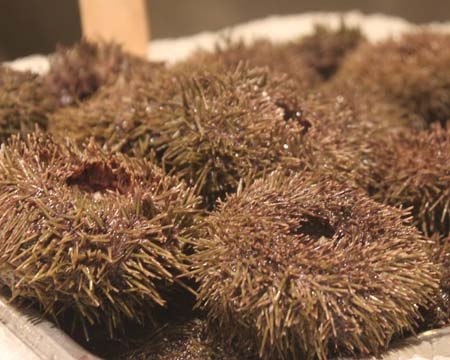A Chef's Secrets For Cooking Fish
It's not often that you walk around Chelsea Market with a man wearing a skirt — especially one who is a celebrity. A Scottish celebrity chef that is. I recently had the pleasure of perusing the seafood selection at the Lobster Place with chef Michael Smith from The Three Chimneys on Scotland's Isle of Skye to learn about local cookery and how to avoid overcooking fish.
salmon, brown trout, and rainbow trout.
Clearly, Smith knows a lot about fish and seafood with the plethora available to him. So while he was in New York to promote Scotland during Tartan Week, chef Smith toured Chelsea Market with us and shared some of his knowledge, along with the simple secret for perfectly cooking fish.
Check out the tips and tricks that we learned from Chef Smith below — plus the curious way Scottish fishermen eat their scallops.
How to Cook the Freshest Fish
Chef Smith says to make sure that the fish is at room temperature, not warm, but not straight from the refrigerator. You don't want to overcook the fish, so if the center is cold, then it won't cook evenly. With room-temperature fish, get a pan really hot, add a little butter/oil and salt and put the fish in it. Sear it quickly on one side so it gets a little crust then immediately remove from the heat, flip the fish over, leaving it in the pan.
The heat from the pan will permeate through to cook the fish from the bottom up, while the side that was initially on the heat will also continue to cook the fish from the top down — this way you will never have to worry about overcooking it. With this method, you are not cooking the fish all the way through, but if you are using really fresh fish, then that's what you want to do (this also works with other seafood like scallops). About taking the fish off the heat and letting it sit, he says, "You let meat rest, so why not do the same with fish?"
For poaching, he recommends bringing whatever the poaching liquid is to a simmer, then taking it off the heat, and putting the fish in. "This way you'll get lovely moist meat." But he notes that the fish should never be on the heat. "Heat is your enemy when cooking fish."
Oysters are natural energy boosters and are full of zinc. If you're feeling down, he recommends eating three, and says that you'll be ready to go for the rest of the afternoon. The oysters that he uses are ensured to be the freshest quality because Scotland actually has a law that requires the water to be tested and free of contaminants for at least one month before the oysters can be harvested. (Luckily, there is very little pollution around the Isle of Skye.)
For lunch out on their boats, local fishermen shuck a fresh scallop, put a little whisky on it, and eat it like a ceviche. We had the pleasure of trying a scallop prepared this way when we went to a lunch cooked by chef in New York City — it was delicious. But chef says that you can try this with almost any type of seafood. For fresh fish or scallops, put some bourbon in it or single-malt whisky (the purest form of whisky) and eat it. If you don't use a single-malt, then it will be a blend and won't be as pure.
How to Cure Salmon with Whisky
Smith cures farmed salmon for gravlax and uses whisky to do it. A single malt is too expensive, so they cover the fish in a blend for 24 hours, cure it with salt and sugar for another 24 hours, then lay it on acetate, put on a layer of single-malt whisky, and then refrigerate it until it's ready to be served.
Click here to see the Three Salmon Kedgeree recipe.
All photos courtesy of Maryse Chevriere

